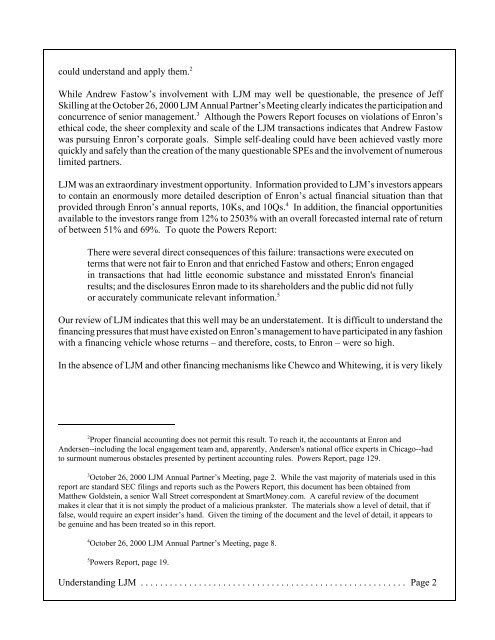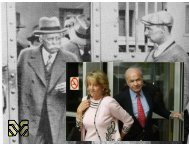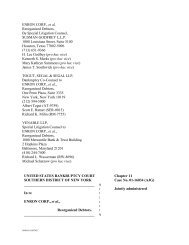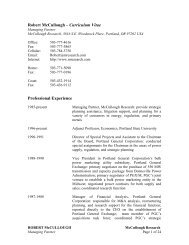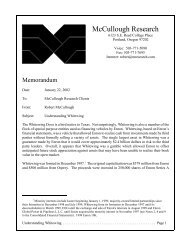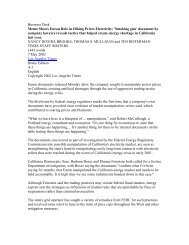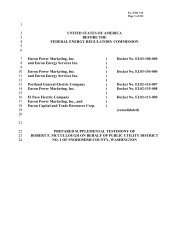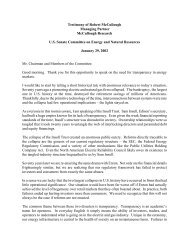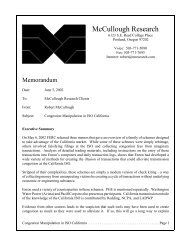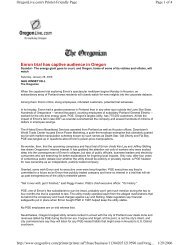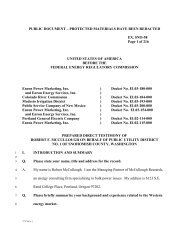Understanding LJM - McCullough Research
Understanding LJM - McCullough Research
Understanding LJM - McCullough Research
You also want an ePaper? Increase the reach of your titles
YUMPU automatically turns print PDFs into web optimized ePapers that Google loves.
could understand and apply them. 2<br />
While Andrew Fastow’s involvement with <strong>LJM</strong> may well be questionable, the presence of Jeff<br />
Skilling at the October 26, 2000 <strong>LJM</strong> Annual Partner’s Meeting clearly indicates the participation and<br />
concurrence of senior management. 3 Although the Powers Report focuses on violations of Enron’s<br />
ethical code, the sheer complexity and scale of the <strong>LJM</strong> transactions indicates that Andrew Fastow<br />
was pursuing Enron’s corporate goals. Simple self-dealing could have been achieved vastly more<br />
quickly and safely than the creation of the many questionable SPEs and the involvement of numerous<br />
limited partners.<br />
<strong>LJM</strong> was an extraordinary investment opportunity. Information provided to <strong>LJM</strong>’s investors appears<br />
to contain an enormously more detailed description of Enron’s actual financial situation than that<br />
provided through Enron’s annual reports, 10Ks, and 10Qs. 4 In addition, the financial opportunities<br />
available to the investors range from 12% to 2503% with an overall forecasted internal rate of return<br />
of between 51% and 69%. To quote the Powers Report:<br />
There were several direct consequences of this failure: transactions were executed on<br />
terms that were not fair to Enron and that enriched Fastow and others; Enron engaged<br />
in transactions that had little economic substance and misstated Enron's financial<br />
results; and the disclosures Enron made to its shareholders and the public did not fully<br />
or accurately communicate relevant information. 5<br />
Our review of <strong>LJM</strong> indicates that this well may be an understatement. It is difficult to understand the<br />
financing pressures that must have existed on Enron’s management to have participated in any fashion<br />
with a financing vehicle whose returns – and therefore, costs, to Enron – were so high.<br />
In the absence of <strong>LJM</strong> and other financing mechanisms like Chewco and Whitewing, it is very likely<br />
2 Proper financial accounting does not permit this result. To reach it, the accountants at Enron and<br />
Andersen--including the local engagement team and, apparently, Andersen's national office experts in Chicago--had<br />
to surmount numerous obstacles presented by pertinent accounting rules. Powers Report, page 129.<br />
3<br />
October 26, 2000 <strong>LJM</strong> Annual Partner’s Meeting, page 2. While the vast majority of materials used in this<br />
report are standard SEC filings and reports such as the Powers Report, this document has been obtained from<br />
Matthew Goldstein, a senior Wall Street correspondent at SmartMoney.com. A careful review of the document<br />
makes it clear that it is not simply the product of a malicious prankster. The materials show a level of detail, that if<br />
false, would require an expert insider’s hand. Given the timing of the document and the level of detail, it appears to<br />
be genuine and has been treated so in this report.<br />
4 October 26, 2000 <strong>LJM</strong> Annual Partner’s Meeting, page 8.<br />
5<br />
Powers Report, page 19.<br />
<strong>Understanding</strong> <strong>LJM</strong> ....................................................... Page 2


